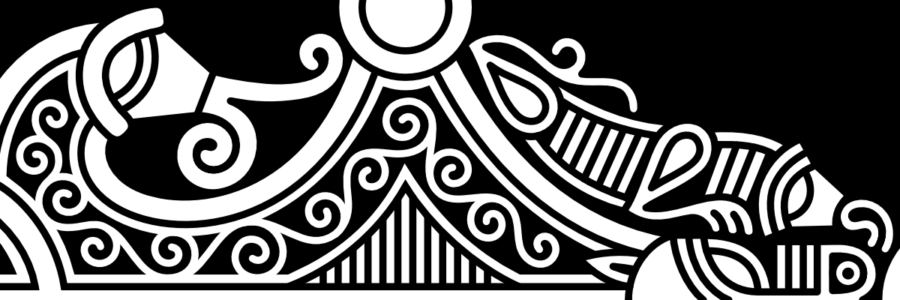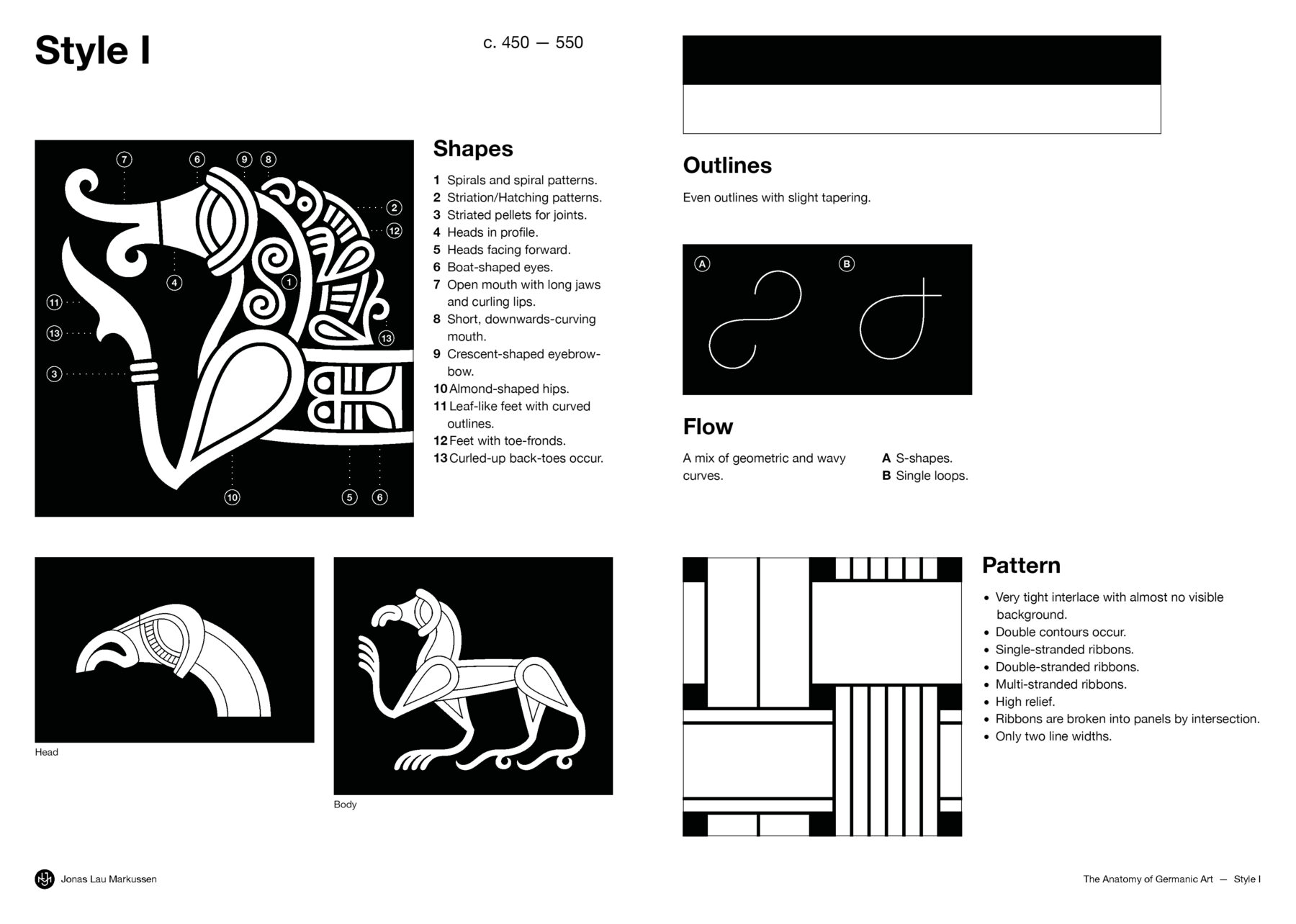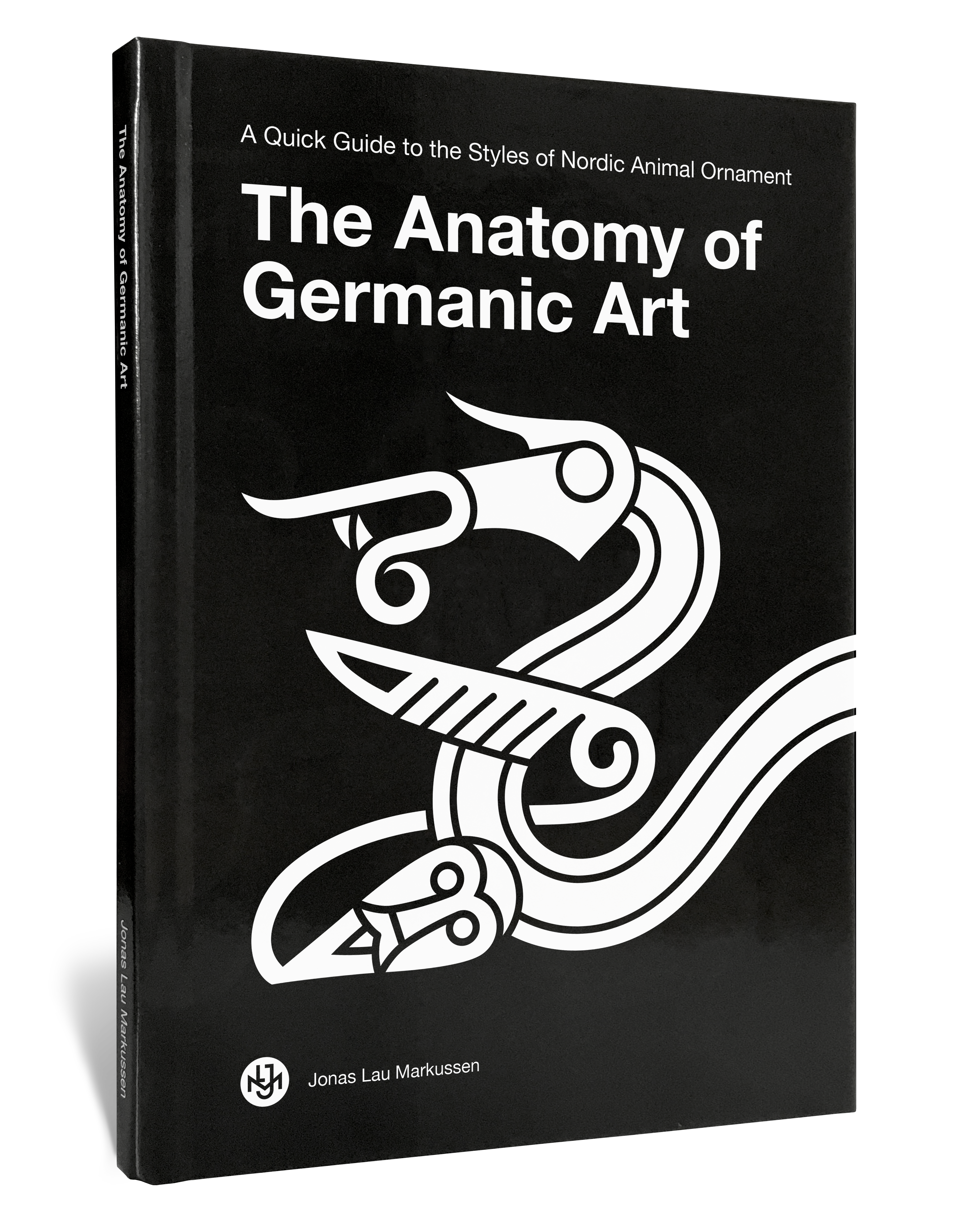
Style I
July 18, 2018
The Anatomy of Germanic Art
The Anatomy of Style I
c. 450 – 550
Shapes
1. Spirals and spiral patterns.
2. Striation/Hatching patterns.
3. Striated pellets for joints.
4. Heads in profile.
5. Heads facing forward.
6. Boat-shaped eyes.
7. Open mouth with long jaws and curling lips.
8. Short, downwards-curving mouth.
9. Crescent-shaped eyebrow-bow.
10. Almond-shaped hips.
11. Leaf-like feet with curved outlines.
12. Feet with toe-fronds.
13. Curled-up back-toes occur.
Outlines
Even outlines with slight tapering.
Flow
A mix of geometric and wavy curves.
A. S-shapes.
B. Single loops.
Pattern
- Very tight interlace with almost no visible background.
- Double contours occur.
- Single-stranded ribbons.
- Double-stranded ribbons.
- Multi-stranded ribbons.
- High relief.
- Ribbons are broken into panels by intersection.
- Only two line widths.
Composition
- Carpet-pattern distribution of motifs and shapes of equal size and equal compositional value (A, C).
- A combination of geometric and zoomorphic framework (A).
- Compositions based on line symmetry (A, B).
- Triskellion or swastika compositions of 3-fold and 4-fold rotational-symmetrical animal heads (D).
Motifs
- Geometric patterns (A, D).
- Four-legged animals (A, B).
- Animal Heads (A, D).
- Human figures (C).
Rise of New Kingdoms
The Vandals sack Rome
The Vandals were a Germanic people who first inhabited what is now southern Poland. In the fifth century, they established Vandal kingdoms on the Iberian Peninsula, Mediterranean islands, and North Africa. In 455, they invaded Rome, led by King Genseric. They pillaged the city for two weeks, causing widespread destruction.
The Last Roman Empire in the West
Romulus Augustulus, the last Western emperor, was deposed as a child by the Germanic leader Odoaker, marking the end of an era. Odoaker, seizing power, became king of Italy.
Ostrogoths
The Ostrogoths, led by Theodoric the Great, conquered the Italian peninsula. Theodoric imprisoned the Pope, who died in his custody, and Theodoric himself met a mysterious end, possibly through poison, a few days later. The story of Hildebrand and Hadubrand in Hildebrandslied is set against the background of the historical conflict between Theodoric and Odoacer, which became a significant subject for Germanic heroic legend. The Ostrogoths eventually lost power to the East Roman Emperor Justinian and disappeared from history. The Swedish Rök runestone from the beginning of the 8th century commemorates Theoderic and describes a statue of Charlemagne.
The Frankish Empire
Clovis, the first king of the Franks, marked the birth of the Merovingian dynasty. Clovis, initially a pagan, converted to Christianity around 500. His baptism symbolised a fusion of Germanic warrior culture with the Christian faith. However, Clovis died a few years later, leaving a divided Merovingian kingdom behind. The Danish king Chochilaicus challenged Clovis’s heir, Theuderic, and launched raids along the southern coast of the North Sea. These maritime clashes foreshadowed the broader Scandinavian migration that would impact Britain and beyond.
Britain
The Battle of Badon c. 500, somewhere at an unknown location in England, saw Britons clash with the Angles. The Angles, first mentioned by the Roman historian Tacitus in 98, hailed from southern Jylland and northern Germany. Their migration to England, alongside the Saxons and Jutes, transformed the islands’ disposition. The English kings, seeking protection from Scots and Picts, allied with the Saxons, who, in turn, joined forces with the Angles and Jutes. Together, they carved out new territories in England around 450. According to Bede and The Anglo-Saxon Chronicle, two Jute kings who conquered Kent, Horsa and Hengast, were among the Jutes driven out of Scandinavia by the Danes.
Scandinavia
In Scandinavia, new religious centres of influence emerged. Uppåkra was a settlement in Skåne, Sweden, from c. 100. During this period, it was a thriving Iron Age community. The site was situated on the ancient main road between Trelleborg and Helsingborg, becoming an important religious, economic, and political centre. A temple built in the 6th century demonstrated its importance as a central religious place. Gamla Uppsala, a little north of Stockholm, Sweden, was another main religious, economic, and political Scandinavian centre gaining importance during this period. The site contains several burial mounds, the three largest are known as the Royal Mounds. These mounds likely date from the 6th century. Nearby, a burnt giant hall hints at grand feasts and epic sagas. Vendel and Valsgärde, located near Gamla Uppsala, were two burial grounds for some of the region’s richest and most powerful individuals. The elaborate graves speak of incredible material and martial power.
Shapeshifting Bodies, Beasts and Birds
Development
Style I employs a couple of strategies to create a dense ornament image. It’s not quite animal ornamentation as we know it from later styles, composed of ribbon-animal knotwork. Instead, it comprises geometric patterns and human and animal bodies cramped together to create an impenetrable carpet of surface-covering ornamentation. The animal- and human-figure motifs carrying over from the Early Animal Style are deliberately employed to create distinct imagery. Although the individual animals are only juxtaposed and never really overlap to create interlace patterns, they are almost imperceivable as separate animal bodies. They are meant to melt together visually, creating an ambiguous image that never settles in one specific shape.
Bow Brooches
The square- and radial-headed brooches are undoubtedly the most iconic and recognisable items of Style I. They follow the same overall template inspired by Continental European brooches. The head and body usually feature geometric ornamentation with some animal ornamentation. The body comprises a cross, often with animal-head terminals seen in front. At the top of the cross below the head, two animal heads protrude outwards and downwards.
Cups and Horns
Cups and horns with decorated metalwork rims display some of the style’s more unique characteristics. Human figures are folded in on themselves and into the small foil frames. Their limbs are crisscrossed, and the compositions almost resemble the ribbon animals and gripping beasts of later Nordic animal ornament. The individual human figures are much harder to discern than those in the Early Animal Style.
Ring Swords
Ring swords, characterised by a ring fixed to the hilt, are exclusive to the Germanic Iron Age. Swords from this period feature motifs identical to the cups, horns, and brooches and are often adorned with exquisite animal ornament.
Examples
Examples on Gelmir.com →
A list of examples with photos, info and links to sources.
Animal-shaped Buckle
Snartemo, Agder, Norway.
Kulturhistorisk Museum, Oslo, C26001/b.
Cup — Snartemo
Snartemo, Agder, Norway.
Kulturhistorisk Museum, Oslo, C26001/v.
Cup — Uppåkra
Uppåkra, Skåne, Sweden.
Historiska museet vid Lunds universitet.
Drinking Horn Mounts
Taplow, Buckinghamshire, England.
The British Museum, London, 1883,1214.19.
Radiate-headed Brooch
Dalshøj, Bornholm, Denmark.
Nationalmuseet, København, DNF 1/51.
Square-headed Brooch — Bratsberg
Bratsberg, Telemark, Norway.
Kulturhistorisk Museum, Oslo, C26566.
Square-headed Brooch — Falkum
Falkum, Telemark, Norway.
Kulturhistorisk Museum, Oslo, C21856/b.I.
Square-headed Brooch — Fonnås
Fonnås, Innlandet, Norway.
Kulturhistorisk Museum, Oslo, C8154.
Square-headed Brooch — Hove Mølle
Hove Mølle, Sjælland, Denmark.
Nationalmuseet, København, 10739.
Square-headed Brooch — Kvåle
Kvåle, Vestland, Norway.
Universitetsmuseet i Bergen, Bergen, B6516
Square-headed Brooch — Lundbjers
Lundbjers, Gotland, Sweden.
Gotlands Museum, Visby, GFC7182.
Square-headed Brooch — Søtvet
Søtvet, Vestfold, Norway.
Kulturhistorisk Museum, Oslo, C9441.
Sword — Snartemo, C28026
Snartemo, Agder, Norway.
Kulturhistorisk Museum, Oslo, C28026/a.
Sword — Snartemo, C26001
Snartemo, Agder, Norway.
Kulturhistorisk Museum, Oslo, C26001.





